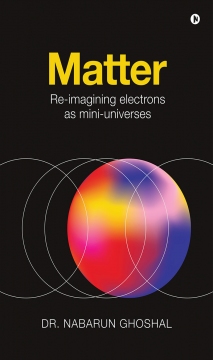
- Discover books
- For Writers
-
For Writers
-
Indie Author Championship
-
Challenges
Writing Contests
- Get Started

"It was a wonderful experience interacting with you and appreciate the way you have planned and executed the whole publication process within the agreed timelines.”
Subrat SaurabhAuthor of Kuch Woh Pal -
-
-
IN
- India
- Singapore
- Malaysia
- UAE
- 0
Dr. Nabarun Ghoshal
The author comes from a modest family in Dhanbad, a town in the coal field area in Jharkhand (erstwhile Bihar), India. He studied in the prestigious Ramakrishna Mission Vidyapith, Purulia and Ramakrishna Mission Residential College, Narendrapur enjoying complete freeship under the Government of India Merit Scholarship scheme. He graduated from R G Kar Medical College, Kolkata and since then has been practicing medicine.Physics has been his lifelong fascination. He thinks that this subject can remove all superstitions prevailing in human society. He regrets that the subject has been confined toRead More...
The author comes from a modest family in Dhanbad, a town in the coal field area in Jharkhand (erstwhile Bihar), India. He studied in the prestigious Ramakrishna Mission Vidyapith, Purulia and Ramakrishna Mission Residential College, Narendrapur enjoying complete freeship under the Government of India Merit Scholarship scheme.
He graduated from R G Kar Medical College, Kolkata and since then has been practicing medicine.
Physics has been his lifelong fascination. He thinks that this subject can remove all superstitions prevailing in human society. He regrets that the subject has been confined to a certain class of scholars, instead of being dissipated among the common people of the world in an understandable form.
Crop your profile image

Matter
Books by Dr. Nabarun Ghoshal
How would the universe appear to an observer who is larger than it? A pulsating material body or an inflating balloon? In 1997, scientists were trying to find the amount of "Dark Matter" needed to slow down the expansion of the universe. Surprisingly, comparing the brightness of the supernovae of the distant and nearby galaxies, they found that the universe was actually inflating at an accelerated rate. It was guessed that there must be some "Dark Energy" that
How would the universe appear to an observer who is larger than it? A pulsating material body or an inflating balloon? In 1997, scientists were trying to find the amount of "Dark Matter" needed to slow down the expansion of the universe. Surprisingly, comparing the brightness of the supernovae of the distant and nearby galaxies, they found that the universe was actually inflating at an accelerated rate. It was guessed that there must be some "Dark Energy" that was pushing the galaxies from each other. The author interprets their observation in a reverse way by correcting a probable mistake and shows it as concrete evidence of the slowing down of the universe, which speaks in favour of the presence of the Dark Matter that the scientists were initially looking for. By doing this, he tries to re-establish the theory of the pulsating universe as conjectured by the scientists of the twentieth century and negates the concept of "the beginning of time". He also extends this to a "theory of pulsating electrons", which leads to a new way of understanding the equations of Maxwell and Einstein and finally to the mode of existence of the material world as a whole.

Are you sure you want to close this?
You might lose all unsaved changes.
Select from one of our global stores to continue
 India
India
 Malaysia
Malaysia
 Singapore
Singapore
 UAE
UAE
Warning Message
The items in your Cart will be deleted, click ok to proceed.










